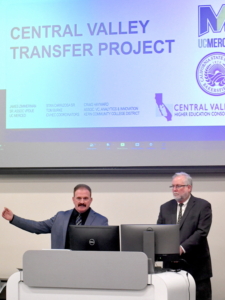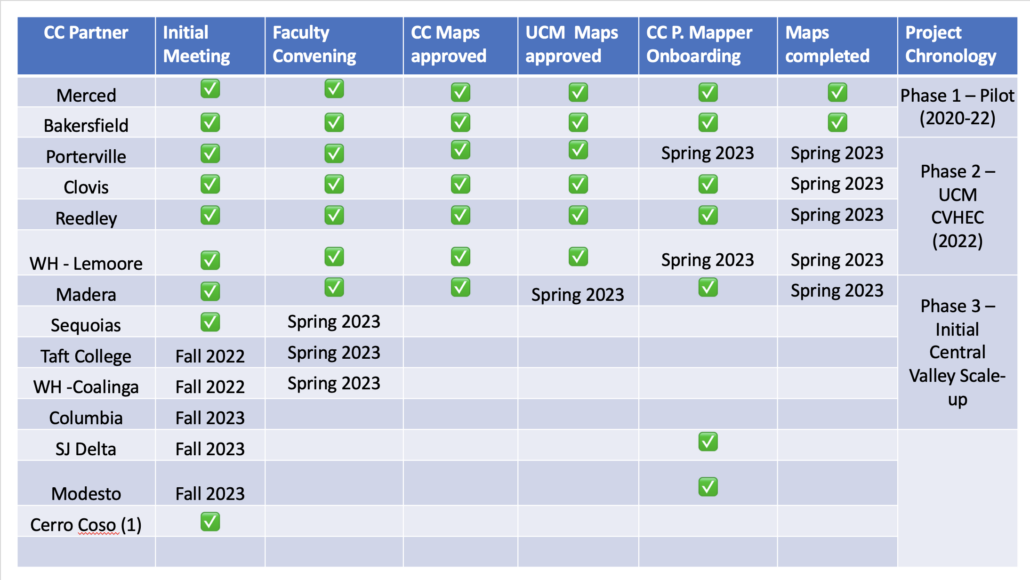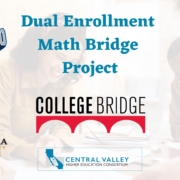Survey of 5,000 Frosh Shows Direct Correlation
Between Program Pathways Mapper and Student Success
A recent survey shows very positive student success outcomes for the Central Valley Higher Education Consortium’s Transfer Project and Program Pathways Mapper as the consortium continues to lead a concentrated effort to increase the number and success of community college transfers from the nine-county region to four-year colleges and universities.

CVHEC coordinators Stan Carrizosa and Tom Burke present the Transfer Project and its Program Pathway Mapper to the consortium board of directors at its quarterly convening Dec. 8 in Clovis.
This successful effort is also being recognized widely as the Transfer Project team delivers presentations statewide about the project that began in 2019 — in response to grave concerns for the low number of Central Valley community college transfers to the valley’s University of California campus in Merced – and has grown to nine community colleges and three four-year institutions (see breakdown below) with others inquiring from throughout the state.
In the first round of results being compiled for the project’s two pilot colleges – consortium members Bakersfield College and Merced College – the data in a sample of over 5,000 incoming Bakersfield freshmen shows a direct correlation between students using the Program Mapper and important student success metrics, reports Stan Carrizosa, the consortium’s southern regional coordinator who is the CVHEC Transfer Project lead.
“This includes a significant increase in the number of ‘on-path’ courses successfully completed each semester, elimination of the achievement gap for underrepresented students in their on-path completion rates and a sharp reduction in the total number of units-to-degree completion for all students using Program Mapper,” said Carrizosa who presented an update at the CVHEC Board of Directors winter meeting Dec. 8 along with Tom Burke, CVHEC’s Transfer Project coordinator.
The project’s Pathways Program Mapper is a public internet-based software application that presents students with pre-approved course sequences aligning the community college Associate Degree for Transfer (ADT) with the upper division requirements by major, for successful degree completion.
Now, what started as a pilot project to increase transfers to UC Merced has grown beyond the Central Valley to regions statewide, the pair reported to the board, with invitations last fall for CVHEC’s Transfer Project team to present at conferences and workshops including the Lumina Foundation State Policy Retreat 2022, the Association of Chief Business Officials and the annual convention of the Community College League of California.
“We have also been working with representatives from the California State University Chancellor’s Office to come together and combine our respective efforts in this area, further streamlining and strengthening our transfer pathways model,” said Carrizosa, who is also president-emeritus of College of Sequoias.
“Our Transfer Project Team now convenes representatives from CVHEC, the UC and CSU creating an intersegmental collaborative group that is indeed the first of its kind,” he reported. “In most districts where we are engaging in this work, we are also reaching out to include local K-12/high school districts to align with their efforts as well.”
Burke added that, in addition to the two trailblazers Bakersfield and Merced, five fellow CVHEC members are scheduled to go live this semester: Porterville College, Reedley College, Clovis Community College, West Hills Lemoore College and Madera College. Taft College and West Hills Coalinga College will begin the onboarding process this semester.
Four-year partners who are fully up and live are the University of California, Merced and CSU Bakersfield with Stanislaus State beginning the onboarding process this semester. All are CVHEC members as well. And many others are in communication.
“Most recently we have received encouraging feedback from CSU Monterey Bay, UC Irvine and private colleges including Fresno Pacific and National University,” said Burke, who is also chancellor-emeritus of the Kern Community College District.
Burke also reported that the team’s efforts are now being incorporated into the state-funded K-16 Regional Collaboratives including most recently the Kern County collaborative.
“These efforts have led to specific state funding for the Transfer Project through line-item support to implement the Program Pathways Mapper, the software vehicle that brings the intersegmental pathways together in a user-friendly, internet-based application,” Burke said.
Now that the first round of results is showing very positive outcomes and state legislation such as Senate Bill 928 for transfer reform providing solid ground support, the interest in CVHEC’s Transfer Project is high and the team stands ready to present.
“As the SB 928 begins to get legs with the formation of a statewide task force to study how to increase transfers, we would welcome an opportunity to share our work,” Burke said. “We have a model including protocols/processes to create intersegmental transfer pathways and proven solutions to the challenges they are still trying to define.”
For information about the project or to arrange a presentation, contact Carrizosa at scarrizosa44@gmail.com.

Related articles:
• Pilot CVHEC/UC Merced Transfer Project improves process for students
• Charting Better Maps to Degrees
• CVHEC BLOG: ‘WHAT THE CV-HEC IS HAPPENING’ (Dec. 2021)
• CV-HEC BLOG: UC Enrollment Push Supported by CVHEC/UC Merced Transfer Project and New Mapper Software
• CVHEC NEWS: Lumina Policy Retreat Presentation
 Pres. Junn, who as a result will also vacate her seat on the Central Valley Higher Education Consortium Board of Directors, shared the news in a video message and letter to campus and community members.
Pres. Junn, who as a result will also vacate her seat on the Central Valley Higher Education Consortium Board of Directors, shared the news in a video message and letter to campus and community members.










